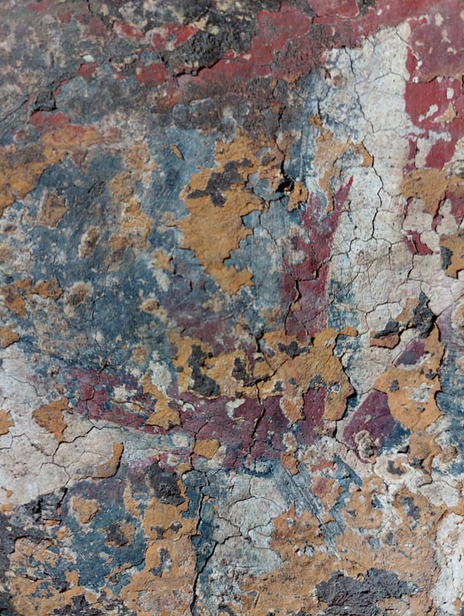This multidisciplinary project, under the leadership of Prof Martina Ullmann of the Ludwig Maximilians University Munich, at the Egyptian Museum Cairo on the wall paintings from the Temple of Amenhotep III at Wadi es Sebua, was undertaken in autumn 2022 and spring 2023.
The wall paintings were historically detached and transferred from the temple in 1964, as a part of the UNESCO rescue operation at the time of the creation of the Aswan High Dam. These unique and highly significant multi-layered paintings, now survive as seven panels, which were in storage in the basement of the Egyptian Museum since their detachment and transfer. The overall aim of this research and conservation project was to enable their display within the museum. The permament exhibition opened in September 2023.
The project involved art historical and iconographical study and research, materials analysis, including XRF to characterize pigments, and complimentary non-invasive analytical and recording techniques including photogrammetry, Reflectance Transformation Imaging, Dstretch, Visible Induced Infrared Luminescence, macro and super-macro photography.
The conservation project, informed by the above techniques, combined with archival research (notably into the work of the conservators in the 1960s and the excavation of the temple at that time), aimed to understand: the original materials and techniques of construction; the deterioration factors; the impacts of later interventions and the materials used; the current conditions, and, using this information, define the conservation treatment plan and materials selection.
Working with a team of conservators from the Egyptian Museum Cairo, I carried out the examination and condition assessment, formulated the treatment plan and undertook the practical conservation work.
While the backing system used in the 1960s transfer appeared, on conservation assessment, to be structurally stable and to still offer good support, the original paintings required conservation treatment to stabilise them and enable display. This work involved: relaying and securing the lifting and flaking paint layers – most critically the highly significant palimpsest layers which showed historical alteration of the iconography; the stabilisation of the original mud plaster substrate; and the reduction of the layers of dirt and surface deposits, accrued over years of storage in the museum basement, which cover the painted surfaces.
It has been particularly interesting, from a personal and professional perspective, having recently worked on the historically transferred Hierakonpolis Tomb 100 wall painting, and carried out research into the practice of wall paintings transfer in the Egyptian context (but not, at that time, accessed the information from the Nubian Campaign) – to work on these panels.
A large part of the UNESCO Nubian campaign wall paintings transfer work was undertaken or aided by a group of conservators from Yugoslavia. A recent conference by the University of Ljubljana, the Institute for Monastic Studies and Contemplative Sciences and the National Museum of Slovenia entitled “Solvenes in Egyptology – International Egyptological Conference at the Occasion of the 200th Anniversary of Champollion’s Decipherment of the Hieroglyphics and the 100th Anniversary of Carter’s Discovery of Tutankhamun’s Tomb” illuminated this background history, with papers on the background of Egyptian-Yugoslav relations at the time of UNESCO’s rescue operation, on the notes and photographs of the Slovenian conservator/photographer of the group, and invaluable information with materials details, notes and images of the work to transfer the paintings from multiple sites across the area. It is hoped that archival research on the Amenhotep III paintings can feed into this research and history as well as benefit from it – in addition to bringing into focus the acknowledged Egyptological significance of these unique temple wall paintings.

Detail of the lifting and flaking paint of the palimsest layers on one of the panels
Image and cover image: Kathryn Piquette, UCL Centre for Digital Humanities, Wadi es Sebua Project.




The paintings after the conservation project, now on permanent display at the museum. And the conservation information panel from the exhibition. Images Martina Ullman Wadi es Sebua Project.
